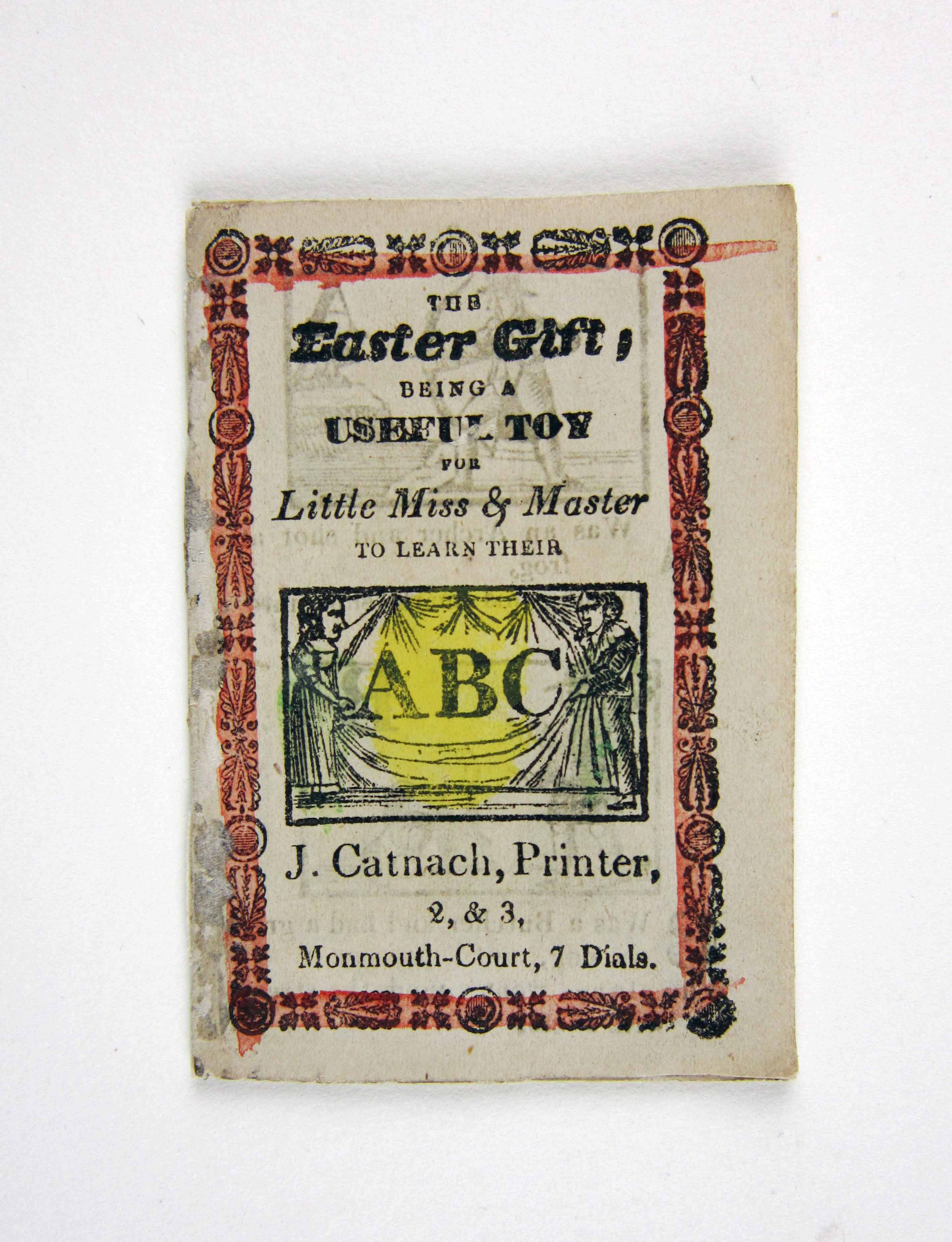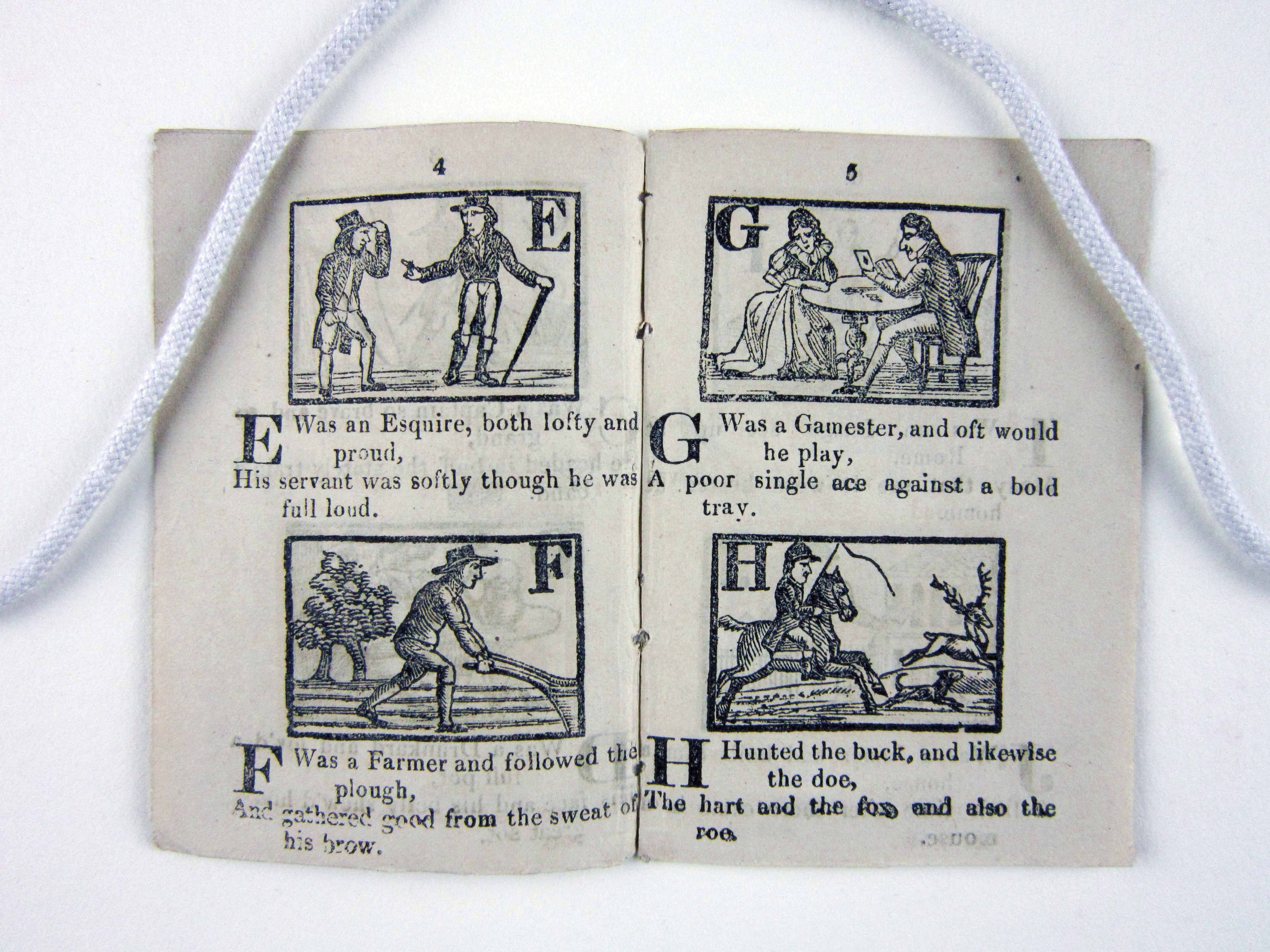

Alphabet books offer a vivid insight into the history of literacy and culture, as well as concepts of childhood. The Children's Book Collection at UCLA contains a rich array of these materials, some well-worn and much-used, some still bright and fresh. Each is a gem of print production and graphical imagery from another time and place. Though the history of alphabet books continues to the present, this exhibit focuses on the works in our collections published between 1700 and 1900, including horn books, primers, works of didacticism and seriousness, whimsy and play.
2. A Jumble ABC
3. A Little Pretty Pocket-Book
4. A New Lottery Book of Birds And Beasts
5. A Pretty Play-Thing for Children of All Denominations
8. ABC of Objects for Home And School
10. ABC with Pictures & Verses
12. Alphabet Et Instruction Pour Les Enfans
16. Dolly's ABC Book
17. Flora's ABC
18. Home ABC
22. Hornbook C. 1700
23. Large Letters for the Little Ones
24. Little ABC Book
25. Little People: An Alphabet
26. Martin's Nursery Battledoor
27. Mother Goose ABC
28. My Darling's ABC
29. Orbis Sensualium Pictus Quadrilinguis
30. People of All Nations: A Useful Toy for Girl Or Boy
31. Picture Alphabet
32. Pretty ABC
33. Railway ABC
34. Rusher's Reading Made Most Easy
38. The Alphabet of Old Friends
40. The Amusing Alphabet for Young Children Beginning To Read
42. The Child's Christian Education
45. The Easter Gift
47. The Favorite Alphabet for the Nursery
49. The Franklin Alphabet And Primer
51. The Golden ABC
55. The Moral And Entertaining Alphabet
57. The Old Testament Alphabet
59. The Picture Alphabet for Little Children
62. The Sunday ABC
63. The Union ABC
64. The Young Child's ABC, Or, First Book
65. Tom Thumb's Alphabet: Picture Baby-Books
67. Warne's Alphabet And Word Book: with Coloured Pictures
68. Wood's Royal Nursery Alphabet
Title The Easter Gift


Brief description A tiny chapbook a little smaller than the size of a playing card. This is an example of the cheap literature widely distributed in the nineteenth century that brought literacy to the masses. Physically, The Easter Book is in good condition although the production quality is not pristine.
Full description The Easter Gift: being a useful toy for little miss and master to learn their ABC was printed in 1813 by J. Catnach, a major English purveyor of cheap literature such as ballads, broadsides, and chapbooks. This tiny chapbook is slightly smaller than the size of a playing card, and its print quality is far from pristine. Paper was expensive in the early 1800s and this book was published for a broad audience who could not afford frivolous waste of resources or fancy printing. Most inexpensive chapbooks such as The Easter Gift would get too battered to pass down one generation, let alone to persist in excellent condition for 200 years such as the one in UCLA's collection. Its ordinariness in the early nineteenth century is what makes its existence today extraordinary. The Easter Gift reflects the growing secularization of children's literature in the early nineteenth century. Unlike earlier children's literature that existed solely for religious instruction, The Easter Gift is written to amuse and entertain children. The alphabet is cast as an "ABC Republic" comprised of "citizen-letters" where the noble "C who was a Captain so brave and so grand" stands side-by-side with "D who was a drunkard and lov'd a full pot." The narrative is full of humor and whimsy, meant to delight children rather than frighten them with piety and damnation the way early primers did. Interestingly, women are used to represent only two of the twenty-six letters, an indication of the limited roles that women are allowed to play in this time period.
Literacy By the time of The Easter Gift's publication in 1813, literacy had become "a necessity of existence" in the Western world. From the sixteenth to the nineteenth century, spurred on by the Protestant Reformation, education and literacy trickled down from the wealthy to the middle class. Education primarily occurred in homes, churches, and "dame" schools to impart the basic skills of reading, writing, and arithmetic. Even with this informal and unregulated system, illiteracy was becoming increasingly rare and stigmatized. The market for alphabet books and children's books exploded in the eighteenth century and children's literature began to emerge as its own distinctive genre. In the nineteenth century, printers such as Catnach turned children's books from a luxury good to an accessible treat for the middle as well as the upper class. The closing statement of The Easter Gift urging children to learn their ABCs in order to be "good" reflects that by 1813 literacy had become a moral imperative, not merely a sign of class and social standing.
Childhood The Easter Gift: being a useful toy for little miss and master to learn their ABC reflects the growing secularization and importance of early childhood education prevalent in nineteenth century culture. This diminutive chapbook employs the technique of casting letters in the alphabet as characters common in early nineteenth century society. The narrative is humorous and irreverent with a mix of high and low culture. Moral lessons, however, inject the nonsensical prose, subtly admonishing children not to steal lest they be hanged ("R was for Robber") or spend extravagantly lest they become poor ("X was expensive"). The parting line, "Let all good children come to me, and I'll learn them their ABC," reflects a notion of that to be a "good" child is to be an educated child, a sentiment of seventeenth century philosopher John Locke that exalts rationality above all else. The notion of childhood expressed by The Easter Gift is that childhood is a time for play but also for learning. Unlike earlier books meant to drill piety into children's psyches, alphabet books such as The Easter Gift teach children through humor and mnemonic devices. Moral lessons still prevail, however, and the expectations of proper children are woven into the clever prose and illustrations.
Iconography The images and text in The Easter Gift are a common format for alphabet books of this time period: a "republic of citizen-letters" representing popular professions and characters of the time period. Captains and kings reside nobly next to drunkards, farmers, and robbers. The majority of the characters are male which reflects the greater diversity in opportunity for males in this time period. The only women represented in the 26 characters are a dull-witted Lady (the letter L) and a woman selling oysters (the letter O). Men, on the other hand, represent a wide spectrum of careers and characters. Cultural values are also expressed in the pithy verses accompanying the letters. From the text the reader can extract that the culture that produced The Easter Gift valued hard work (the letter F), travel (the letter I), and humility (the letter N). The admonition to all "good children" to "learn them their ABCs" shows that the culture also valued literacy and education.
Production The Easter Gift was published in London by J. Catnach, a prolific nineteenth century printer described as "one of the great pioneers in promoting cheap literature." Catnach did not print books for intellectuals, but for the Everyman of the 1800s. His primary output was ballads, broadsides, and chapbooks which, once sold cheap, have now become prized possessions by book collectors. Broadside ballads generally sold for a penny or half penny in London and could be folded up to make chapbooks such as The Easter Gift. Due to the scope of Catnach's business and his goal to make literature widespread, we can assume that many copies were made of The Easter Gift and that it sold for about a penny. Like most of Catnach's work, The Easter Gift was printed primarily in black with very little color. The woodcut illustrations and printing are not pristine due to the high volume and low price of Catnach's production model.
Publisher J. Catnach
Publication place 2 & 3 Monmouth-Court, 7 Dials, London
Date 1813
UCLA Call Number CBC GR486 .E17 1813
Repository UCLA Charles E. Young Research Library, Dept. of Special Collections
Dimensions 91 mm, height
Technologies of production Print, woodcut (process)
Media and Materials Inexpensive paper, folded broadsides
Caption